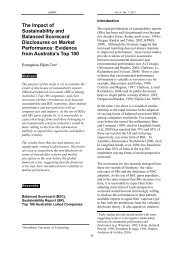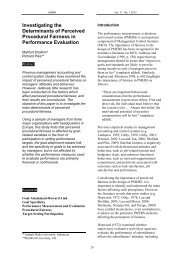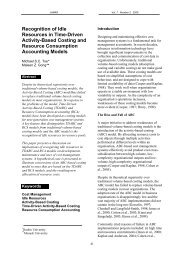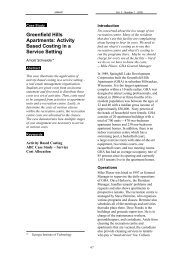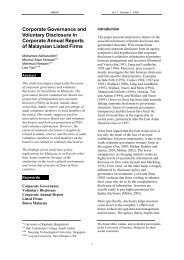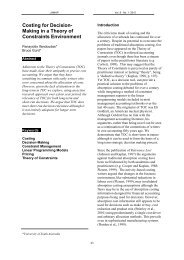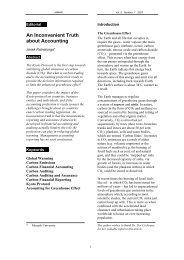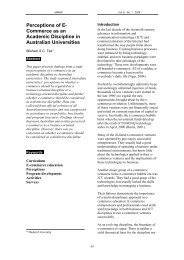Balanced Scorecard Design and Performance Impacts: Some ...
Balanced Scorecard Design and Performance Impacts: Some ...
Balanced Scorecard Design and Performance Impacts: Some ...
You also want an ePaper? Increase the reach of your titles
YUMPU automatically turns print PDFs into web optimized ePapers that Google loves.
JAMAR Vol. 6 · Number 2 · 2008that if establishing significant correlationsbetween measures <strong>and</strong> causal chains wasimmediately obvious <strong>and</strong> easy then the needfor strategy or even management isdiminished. They argue that establishingassociations between outcomes <strong>and</strong> inputsthat are assumed to have the greatest impacton these outcomes is what developing cause<strong>and</strong> effect is about; <strong>and</strong> in manyorganisations these relationships can bediscovered <strong>and</strong> attuned through a process oflearning <strong>and</strong> experimentation over time (seealso Tuomela, 2005).Empirical research is also somewhatunclear on the benefits of using the cause<strong>and</strong> effect characteristic in BSC design.Malina <strong>and</strong> Selto (2001), Malmi (2001) <strong>and</strong>Ittner, et.al. (2003) all found very littleapplication of the cause <strong>and</strong> effect principlein the companies they considered, <strong>and</strong> assuch were only suggestive in theirdiscussions of the usefulness of cause <strong>and</strong>effect logic.Davis <strong>and</strong> Albright (2004), in their study ofbank branches, found that the organisationalunits that used the BSC had better financialperformance that those that had notimplemented the BSC. Notably, the BSCimplementing units had designed them withcause <strong>and</strong> effect logic, although this doesnot allow isolation of the effects of cause<strong>and</strong> effect logic itself. Malina <strong>and</strong> Selto(2004) anecdotally observed the existenceof logic <strong>and</strong> finality in the perceptions ofmanagers in their case study, yet observedlittle evidence of causality when measuringthe relationship between metrics containedin the BSC of their case organisation.Bryant, et.al. (2004) also examined the ideaof causality between financial <strong>and</strong> nonfinancialperformance measures. While theywere able to provide some empiricalevidence of associations, the data used wasfrom external sources <strong>and</strong> hence proxied,rather than directly measured, elements ofthe BSC.Furthermore, associations between financial<strong>and</strong> non-financial measures may existwithout cause <strong>and</strong> effect logic beingpurposefully implemented into BSCdesign.Although both the empirical <strong>and</strong>theoretical evidence surrounding theusefulness <strong>and</strong> applicability of cause <strong>and</strong>effect logic is inconclusive, from apragmatic perspective the notion remainsappealing. Given the normative assertionsof Kaplan <strong>and</strong> Norton concerning itseffectiveness <strong>and</strong> centrality to the BSC as adistinctive strategic management system,the ex ante expectation is that BSCs that aredesigned with causal links betweenmeasures or between measures <strong>and</strong>perspectives will enable greaterperformance outcomes. This is formallystated as the following proposition:P1: Organisations that have cause <strong>and</strong>effect relationships between measures intheir BSC will gain more benefits fromtheir BSC than those without cause <strong>and</strong>effect relationships in their BSC.Compensation Link to BSC Non-Financial MeasuresKaplan <strong>and</strong> Norton (1996b, 2001b) arguethat attaching incentives to measures is apotentially powerful mechanism to align theefforts of individuals to the achievement oforganisational strategy, <strong>and</strong> to create a morebalanced focus between short <strong>and</strong> long termobjectives. They also suggest that astrategically linked scorecard with acompensation element included in thedesign will create the sense that theachievement of strategy is everyone’sresponsibility, motivating individuals toconsciously consider the relationshipsbetween their activities <strong>and</strong> strategicoutcomes.The BSC research literature to date haspresented limited evidence on the benefitsof incorporating reward <strong>and</strong> compensationinto BSC design. Malmi (2001) found 13 ofthe 17 organisations he interviewed hadincentives attached to their BSC, althoughhe did not provide any evidence on whetherimpacted BSC effectiveness. Speckbacher,et.al (2003) also examined the extent towhich incentives were linked to the BSC.Out of 38 organisations, 27 had incentivestied to the BSC, however the extent towhich this impacted either benefits of theBSC or organisational performance is notconsidered.20



